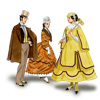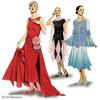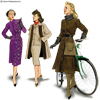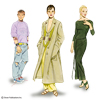Resources / Centuries and Decades
17th century
Exhibits (1)
18-th century
In the 18th century, just like two centuries before, European fashion remains under the influence of France. After some standstill in social life in the last years of Louis XIV reign, new era of enjoyment and thirst for pleasure has set in. Pompousness and splendor of the court attire gave in to the more elegant and graceful forms.
France was the place where in the beginning of the century art style Rococo was formed as an evolution of Baroque. Exquisiteness, graceful ornamental rhythm, attention to sensual situations and mythology, personal comfort - these are the main features of the style.
1800-1840s
In the first half of the nineteenth centuries the influence of military spirit on all aspects of everyday life and a fashion, in particular, was very strong. It was the time of Napoleonic, Crimean and Franco-Prussian wars. The officers were the center of social life and a secular society. Boots, which half a century before were exclusively a prerogative of the military or only used for riding, again appeared in the center of public attention. They remained the basic man's footwear for the most part of the nineteenth century: the military and the civil, regardless of social status, were wearing the boots.
1840-1870
p>The machine-made production was a remarkable achievement of the American industry in the second half of the nineteenth century, resulting in availability of huge quantity of relatively good footwear. Nevertheless, English footwear made to order with a fine dressed leather, remained the best. Just as English wool in clothes, these made to order shoes, became the standard of quality.
Introduction of front lacing half boots with the closed instep, which were named balmoral, was an important event in footwear fashion of the second half of the 19th century. This type of footwear was called after the name of the castle Balmoral, built by the spouse of Queen Victoria Prince Albert (1819-1861) approximately in 1853. The name of the castle - a royal residence in Aberdeenshire, Scotland, from now on became equivalent to anything new and elegant.
1870-1900
In the first half of the nineteenth centuries the influence of military spirit on all aspects of everyday life and a fashion, in particular, was very strong. It was the time of Napoleonic, Crimean and Franco-Prussian wars. The officers were the center of social life and a secular society. Boots, which half a century before were exclusively a prerogative of the military or only used for riding, again appeared in the center of public attention. They remained the basic man's footwear for the most part of the nineteenth century: the military and the civil, regardless of social status, were wearing the boots.
1900-1919s
The beginning of the twentieth century has not brought anything new into the footwear design. Ladies continued to wear long skirts therefore it was seldom possible to have the pleasure to see their shoes. The most popular models of the previous century remained in a fashion until beginning of the First World War.
1920s
The shoe design of the 20s was not the result of the gradual development in fashion. It was a total disruption of the former tradition, which has expressed itself in the riot of colors, textures and an abundance of decorative components. Vogue writes about footwear in 1921: " there is a certain tendency - to depart from the colors that would simply match clothes and to place a tone intentionally contrasting". The hem of a skirt has rapidly risen up to the knees - and even higher in the second half of the 20s, partly reflecting playful mood of the turbulent decade. The footwear now appeared in the center of attention.
1930s
After the crash at the New York stock exchange Great Depression swept over the world, resulting in unemployment and lack of money. Frivolity and luxury in clothes and footwear have given way severe practicality. However the reason was not only dire straits, but also a certain tribute of the present: cubism, art deco preferred geometrical lines, and design decisions of influential architects have pushed the idea of functionality to the foreground.
1940s
The fashion of the forties was under the influence of war, but has not disappeared absolutely as it might have been expected. Fashion magazines have not stopped the activity. They strongly recommended to women to look after themselves as well-groomed appearance helped to increase fighting spirit. This problem was not an easy one. In Europe and in the United States strict restrictions on use of materials and styles were imposed with the beginning of war, thus allowing to redirect the light industry and resources on for the needs of the military.
1950s
Influence of the New Look style has continued into the 1950s, although Dior himself was already bored with it, and he promoted a new silhouette every half-year. Style continued its existence irrespective of the founder. A sandglass silhouette, characteristic for this trend, was manifesting itself everywhere, starting with architecture, interior design and finishing with household goods.
1960s
The idyll of the fifties has ended. The young wanted to change the world and have risen against values of a bourgeois society of the parents. The conflict of "fathers and children", which never till now in history was beyond interpersonal attitudes, has undermined the traditional social device of a society. Young stirrer-up of trouble started to make a strong impact on cultural and economic life in the different countries and even aspired to influence politics.
1970s
The 70s were the time of postmodernism and eclecticism. Everything was mixed and everything was tried – the main goal was self-expression. Retro-kitsch, disco, glamour rock, and ecological consciousness – anything would go under the motto "The best taste is bad taste!" - the more shocking and ridiculous, the better. However, this decade brought a real revolution into the world of fashion. Freedom of self-expression, boldness on and behind an edge of taste, rigid provocation and childish admiration for the ridiculous and ugly – this was the force freeing the creative powers of the seventieth.
1980s
In the 80s names and labels were put everywhere and on everything: never before had the consumer been attaching such importance to these attributes as it was in the eighties. "Dress for success" motto was as acute as never before, and the designer label became the most simple and effective way to show the financial solvency and the social status. Fashion houses could not depend any more exclusively on individual clients. Fashion designers have joined this "game of labels" and were getting enormous profits selling ready-to-wear clothes under their own brands, accessories, licenses and franchises.
1990s
Consequences of the economic and political events in the end of the 80s have soon affected the fashion industry and were reflected primarily in minimalism and ecological style. Natural clear silhouettes lines, simplicity and functionality, accentuated austerity, constrained neutral colors, natural and hi-tech materials characterized clothes of these two trends.
Birkenstock sandals and footwear made of various materials - leather substitutes and the retreated raw materials, enabling feet "to breathe", became an indispensable part of the wardrobe. The aspiration of the man of the end of the second millennium to return back "to roots", desire to be "closer to the nature" was often limited to creation of the image of a traveler, whose necessary attributes were hiking boots from Timberland, Caterpiller or similar brands.
2000-present time
Footwear fashion of 2000s resembles a supermarket, where all the trends of the 20-th century have more or less manifested themselves. With such a great diversity of the trends one have to differentiate stylized design and proper footwear design.
Fashionable stylized design makes the same model look like 40s or 60s with the help of different cut, materials or colors. Shoes can be stylized to like 18-th or 19-th century models or like ethnic footwear with the use of traditional ornaments, beads or fringe.












